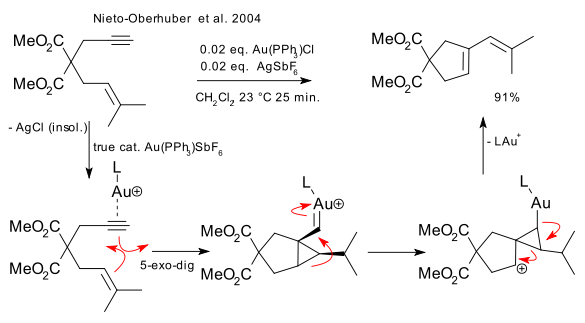- Organogold chemistry
-
Organogold chemistry is the study of compounds containing carbon-gold bonds. They are studied in academic research, but have not received widespread use otherwise. The dominant oxidation states for organogold compounds are I with coordination number 2 and a linear molecular geometry and III with CN = 2 and a planar molecular geometry.[1][2][3] The gold carbide Au2C2 was discovered in 1900.
Contents
Gold(I)
Gold(I) complexes are 2-coordinate, linear, diamagnetic, 14 electron species. They exist as adducts LAuR with as ligand L for instance a triphenylphosphine or an isocyanide. The ligand prevents reduction of Au(I) to metallic Au(0) with dimerization of the organic residue. Gold(I) can also exist as the aurate MAuR2 (the ate complex) whereby the cation is usually fitted with a complexing agent to improve stability. The AuR2- anion is also linear just as other M(d10) species such as Hg(Me)2 and Pd(Me)22+. Gold is known to form acetylides (capable of forming polymeric structures), carbenes and carbynes. The classic method for the preparation of LAuR compounds is by reaction of a Grignard reagent with a gold(I) halide. A subsequent reaction with a organolithium R-Li forms the ate complex.
In a special group of compounds, an aryl carbon atom acts as a bridge between two gold atoms. One such compound, MesAu5,is formed in a reaction between Au(CO)Cl and the mesityl Grigard. Carbon can be coordinated with gold up to a value to 6. Compounds of the type C(AuL)4 are isolobal with methane and those of type C(AuL)5+ isolobal with the methanium ion.
Gold cyanide compounds (MAu(CN)2) are of some importance to gold cyanidation, a process for the extraction of gold from low-grade ore. The carbon to metal bond in metal cyanides is usually ionic but evidence exists that the C-Au bonding in the gold cyanide ion is covalent.[4]
Gold(III)
Gold(III) complexes are 4 coordinate, square planar, diamagnetic, toxic, 16 electron species. When the formal coordination number is less than 4, ligands such as chlorine can make up for it by forming a bridging ligand. Intramolecular chelation is another strategy. In general gold(III) compounds are toxic and therefore less studied than gold(I). For all practical purposes the chemistry is confined to monoarylgold(III) complexes.
Gold catalysis
Gold-catalyzed reactions fall into two major categories: heterogeneous catalysis including catalysts by gold nanoparticles and thiol-monolayer gold surfaces, and homogeneous catalysis that occurs with gold(I) or gold(III) compounds and is used for organic synthesis.[5] Common commercially available gold catalysts are gold(I) chloride, gold(III) chloride, chloroauric acid and a range of gold phosphines such as chloro(triphenylphosphine)gold(I) . To increase the electrophilicity at the gold center, a more dissociated complex can be created through halide abstraction with an additive like silver triflate (AgOTf).
Gold coordinates preferentially to alkene or alkyne bonds, and bonds following the Dewar-Chatt-Duncanson model. Gold is certainly not the only metal showing this type of bonding and reactivity, several metal ions isolobal with the simple hydrogen proton (cationic: emptied s-orbital) do as well: mercury(II) and platinum(II). In 2007 Furstner & Davies [6] proposed the term pi-acid as a cognomen for this type of ion (See also: cation-pi interaction).
The resulting metal-multiple bond complex is electrophilic in nature and activated for nucleophilic attack. In oxymercuration the resultant organomercurial species is generated stoichiometrically, and requires an additional step to liberate the product. Facile protonolysis of the Au-C bond enables true catalysis. Other advantages of gold(I) catalysis include: air stability (high oxidation potential of Au(I) to Au(III) is a barrier to oxidation), lowered oxophilicity and thus tolerance towards water and alcohols, C-Au bonds that prefer protodeauration over beta-hydride elimination, and relative non-toxicity.[7]
An early example of catalysis by gold was described by Ito in 1986 [8] who reacted benzaldehyde and methyl isocyanoacetate with a chiral ferrocenylphosphine ligand and cationic gold(I) compound (Au(cHexCN)2)BF4 to form a chiral oxazoline. This reaction was a first in more than one way: asymmetric Aldol reactions already existed but this was also the first catalytic one.
In a simple mechanistic picture, gold(I) simultaneously coordinates to two phosphine ligands and the carbon isocyanate group [9] which is then attacked by the carbonyl group. Further studies on the bonding mode of Au(I) indicate that this simple picture may have to be revised.
In 1976, Thomas and coworkers reported conversion of phenylacetylene to acetophenone using tetrachloroauric acid in a 37% yield.[10] In this reaction gold(III) was used as a homogeneous catalyst replacing mercury in oxymercuration. Interestingly, this same study lists a published yield >150%, indicating catalysis that perhaps was not acknowledged by the chemists.
Utimoto reacted gold(III)(NaAuCl4) with alkynes and water.[11] Teles identified a major drawback of this method as Au(III) was rapidly reduced to catalytically dead metallic gold and returned to the theme of ligand supported Au(I) for the same transformation [12]:
Another example of an Au(III) catalysed reaction (Hashmi et al. 2000) is in a forced alkyne / furan Diels-Alder reaction - these do not normally occur - ultimately forming a phenol [13]:
Further mechanistic studies conclude that this s not a concerted transformation, but rather an initial alkyne hydroarylation followed by a series of non-obvious intramolecular rearrangements, concluded with a 6-pi electrocyclization and rearomatization.
Heterogeneous gold catalysis is an older science. Gold is an attractive metal to use because of its stability against oxidation and its variety in morphology for instance gold cluster materials. Gold has been shown to be effective in low-temperature CO oxidation and acetylene hydrochlorination to vinyl chlorides. The exact nature of the catalytic site in this type of process is debated.[14] The notion that gold can catalyse a reaction does not imply it is the only way. However, other metals can do the same job inexpensively, notably in recent years iron (see organoiron chemistry).
Gold catalyzed reactions
Gold catalyzes many organic transformations, usually carbon-carbon bond formation from Au(I), and C-X (X = O, N) bond formation from the Au(III) state, due to that ion's harder Lewis acidity. Hong C. Shen summarized homogeneous reactions forming cyclic compounds into 4 main categories [15]:
- heteroatom nucleophilic addition to unsaturated C-C bonds, especially to form small heterocycles (furans, pyrroles, thiophenes)
- Hydroarylation: basically a Friedel-Crafts reaction using metal-alkyne complexes. Example, the reaction of mesitylene with phenylacetylene [16]:
- Enyne cyclization, in particular cycloisomerization, one early example being an 5-exo-dig 1,6 enyne cycloisomerization:[17]
- The soft gold(I) ion coordinates exclusively to the more pi-basic alkyne, leaving the alkene free to attack as the nucleophile.
- cycloaddition reactions with early example the cycloaddition of an nitrile oxide with an alkyne.[18]
Other reactions are the use of gold in C-H bond activation [19] and Itoh Aldol reactions (1990's). Gold also catalyses coupling reactions [20].
References
- ^ C. Elschenbroich, A. Salzer Organometallics : A Concise Introduction (2nd Ed) (1992) from Wiley-VCH: Weinheim. ISBN 3-527-28165-7
- ^ Organogold Chemistry: II Reactions R.V. Parish Gold Bulletin 1997 Link
- ^ Organogold Chemistry: III Applications R.V. Parish Gold Bulletin 1997 Link
- ^ Evidence of Significant Covalent Bonding in Au(CN)2− Xue-Bin Wang, Yi-Lei Wang, Jie Yang, Xiao-Peng Xing, Jun Li and Lai-Sheng Wang J. Am. Chem. Soc., 2009, 131 (45), pp 16368–16370 doi:10.1021/ja908106e
- ^ Gold catalysis for organic synthesis F. Dean Toste (Editor) Thematic Series in the Open Access Beilstein Journal of Organic Chemistry
- ^ Review Catalytic Carbophilic Activation: Catalysis by Platinum and Gold Acids Alois Fürstner , Paul W. Davies Angewandte Chemie International Edition 2007 Volume 46 Issue 19, Pages 3410 - 3449 doi:10.1002/anie.200604335
- ^ Recent advances in syntheses of heterocycles and carbocycles via homogeneous gold catalysis. Part 1: Heteroatom addition and hydroarylation reactions of alkynes, allenes, and alkenes Hong C. Shen Tetrahedron Volume 64, Issue 18, 28 April 2008, Pages 3885-3903 doi:10.1016/j.tet.2008.01.081
- ^ Catalytic asymmetric aldol reaction: reaction of aldehydes with isocyanoacetate catalyzed by a chiral ferrocenylphosphine-gold(I) complex Yoshihiko. Ito, Masaya. Sawamura, Tamio. Hayashi J. Am. Chem. Soc., 1986, 108 (20), pp 6405–6406 doi:10.1021/ja00280a056
- ^ Chiral cooperativity: the nature of the diastereoselective and enantioselective step in the gold(I)-catalyzed aldol reaction utilizing chiral ferrocenylamine ligands Antonio Togni, Stephen D. Pastor J. Org. Chem., 1990, 55 (5), pp 1649–1664 doi:10.1021/jo00292a046
- ^ The reactions of alkynes, cyclopropanes, and benzene derivatives with gold(III) Richard O. C. Norman, William J. E. Parr and C. Barry Thomas J. Chem. Soc., Perkin Trans. 1, 1976, 1983 - 1987, doi:10.1039/P19760001983
- ^ Effective transformation of unactivated alkynes into ketones or acetals with a gold(III) catalyst' Yakitoshi Fukuda, Kiitiro Utimoto J. Org. Chem., 1991, 56 (11), pp 3729–3731 doi:10.1021/jo00011a058
- ^ Communication Cationic Gold(I) Complexes: Highly Efficient Catalysts for the Addition of Alcohols to Alkynes J. Henrique Teles , Stefan Brode, Mathieu Chabanas Angewandte Chemie International Edition Volume 37 Issue 10, Pages 1415 - 1418 1998 Link
- ^ Highly Selective Gold-Catalyzed Arene Synthesis A. Stephen K. Hashmi, Tanja M. Frost, and J. W. Bats J. Am. Chem. Soc., 2000, 122 (46), pp 11553–11554 doi:10.1021/ja005570d
- ^ Gold—an introductory perspective Graham J. Hutchings, Mathias Brust and Hubert Schmidbaur Chem. Soc. Rev., 2008, 37, 1759 - 1765, doi:10.1039/b810747p
- ^ Recent advances in syntheses of carbocycles and heterocycles via homogeneous gold catalysis. Part 2: Cyclizations and cycloadditions Hong C. Shen Tetrahedron Volume 64, Issue 34, 18 August 2008, Pages 7847-7870 doi:10.1016/j.tet.2008.05.082
- ^ Gold-Catalyzed Hydroarylation of Alkynes Manfred T. Reetz, Knut Sommer European Journal of Organic Chemistry Volume 2003 Issue 18, Pages 3485 - 3496 doi:10.1002/ejoc.200300260
- ^ Communication Cationic Gold(I) Complexes: Highly Alkynophilic Catalysts for the exo- and endo-Cyclization of Enynes Cristina Nieto-Oberhuber, M. Paz Muñoz, Elena Buñuel, Cristina Nevado, Diego J. Cárdenas, Antonio M. Echavarren Angewandte Chemie International Edition Volume 43 Issue 18, Pages 2402 - 2406 2004 doi:10.1002/anie.200353207
- ^ Gold(III)-catalyzed one-pot synthesis of isoxazoles from terminal alkynes and nitric acid Francesco Gasparrini, Mario Giovannoli, Domenico Misiti, Giovanni Natile, Gianni Palmieri, Luciana Maresca J. Am. Chem. Soc., 1993, 115 (10), pp 4401–4402 doi:10.1021/ja00063a084
- ^ The golden gate to catalysis Anja Hoffmann-Röder and Norbert Krause Org. Biomol. Chem., 2005, 3, 387 - 391, doi:10.1039/b416516k
- ^ Wegner, H. A. and Auzias, M. (2011), Gold for C[BOND]C Coupling Reactions: A Swiss-Army-Knife Catalyst?. Angewandte Chemie International Edition, 50: 8236–8247. doi:10.1002/anie.201101603
See also
- Other chemistries of carbon with other elements in the periodic table.
CH He CLi CBe CB CC CN CO CF Ne CNa CMg CAl CSi CP CS CCl CAr CK CCa CSc CTi CV CCr CMn CFe CCo CNi CCu CZn CGa CGe CAs CSe CBr CKr CRb CSr CY CZr CNb CMo CTc CRu CRh CPd CAg CCd CIn CSn CSb CTe CI CXe CCs CBa CHf CTa CW CRe COs CIr CPt CAu CHg CTl CPb CBi CPo CAt Rn Fr Ra Rf Db Sg Bh Hs Mt Ds Rg Cn Uut Uuq Uup Uuh Uus Uuo ↓ CLa CCe CPr CNd CPm CSm CEu CGd CTb CDy CHo CEr CTm CYb CLu Ac Th Pa CU Np Pu Am Cm Bk Cf Es Fm Md No Lr Chemical bonds to carbon Core organic chemistry Many uses in chemistry Academic research, but no widespread use Bond unknown / not assessed Categories:- Gold compounds
- Organometallic compounds
Wikimedia Foundation. 2010.







